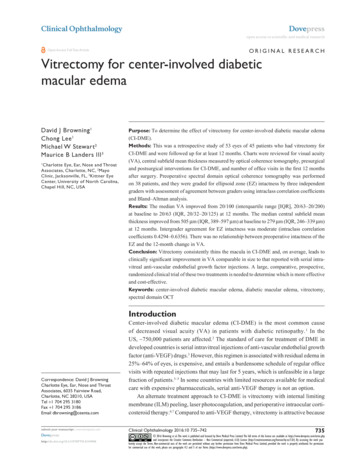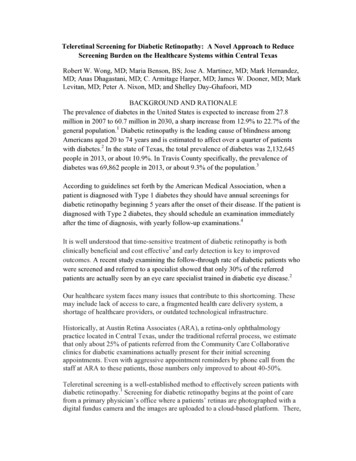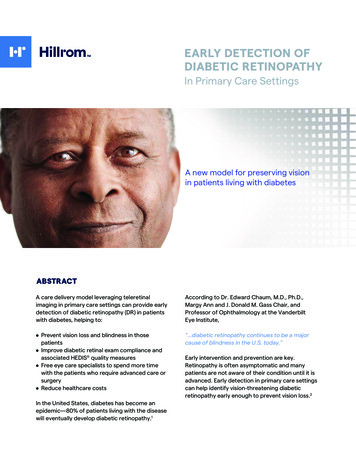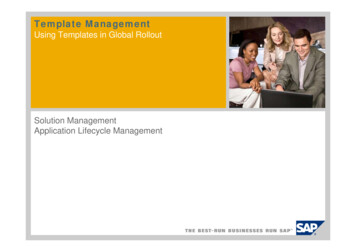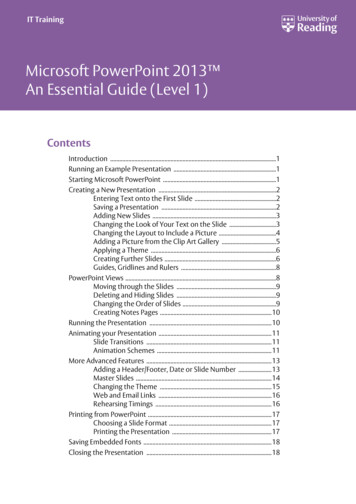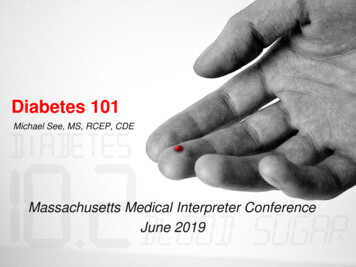
Transcription
Diabetes 101Michael See, MS, RCEP, CDEMassachusetts Medical Interpreter ConferenceJune 2019
Presentation Outline Diabetes in culturally diverse populationsWhat is DiabetesEpidemiologyClassificationsCriteria for diagnosisRisk FactorsPathogenesisApproach to patient managementComplicationsSelf-management – nutrition, physical activity, medication .Treatment and ongoing careCase studies
Presentation ObjectivesAt the end of the presentation, attendees should be able to: Discuss the challenges of managing diabetes in culturally diversepopulations.Describe the criteria for diagnosis and symptoms of diabetes.Discuss the risk factors and pathophysiology of diabetes.List the target for blood glucose, blood pressure and lipids.Discuss the role of nutrition and the benefits of physical activity inthe management of diabetes.List the types of medication for the treatment of diabetes.Describe the complications and long-term risk of diabetes.Discuss the role of diabetes self-management education in assistingPWD to make behavioral changes to manage diabetes.
Important Points Diabetes affects racial/ethic minorities disproportionally Care provided to these groups is often suboptimal Diabetes is a complex, chronic illness requiringcontinuous medical care with multifactorial risk-reductionstrategies beyond glycemic control. Care relies heavily on patient participation, and selfmanagement. Patient-centered interactions are difficult when significantsocio-cultural-linguistic barriers exist. Skilled interpreters is vital for PWD because essentialconcepts in diabetes are difficult to translate.
Medical Interpreters Perspective What types of patient do you translate for?What type of communication difficulties do you observe?To what do you attribute these difficulties?What things should providers know, understand tocommunicate effectively?
Managing Culturally Diverse PWD Acculturation Biology Depression, emotionaldistress Education level Fears Group engagement Health literacy Intimacy/SexualDysfunction Body image Knowledge of diseaseLanguageMedication adherenceNutritionAlternative medicinesQOLReligion, faithSESTechnologyExercise
Social Determinants
Provider Perspective Judging – unilateral approach to patient-providercommunication Cultural competence – respecting cultural differences Unconscious bias – prejudice, unsupported judgement
Interpreters represent an untapped source of insight intocommon patient-provider communication problems. MI interviewed to understand experiences, perceptionsregarding Pt. - Provider communication difficulties.– Differences in ideas about illness, it causes, treatment, meaning– Expectations of clinical encounter– Verbal, non-verbal communication styles can have different meanings Recommendations:–––––Awareness of communication pitfallsImportant to show interest in Pt. country to establish rapportCommunication would be facilitated using simpler, less technical languageUse more conversational style with patientsSchedule time with MI to discuss communication issues
What is Diabetes?
What comes to mind when youthink of diabetes?
Diabetes Diabetes is a disease that affects how you bodyhandles sugar (glucose) “A metabolic disease in which the body’s inability toproduce any or enough insulin causes elevatedlevels of glucose in the blood.”
Diabetes: Myth or Fact Diabetes is a relatively new disease that has come intoexistence with changing lifestyle habits. Diabetes symptoms go back to1552 B.C. when an Egyptianphysician Hesy-Ra, documenteddiabetic symptoms such as frequenturination and drastic weight loss forno apparent reason. 11th century “water tasters” would taste the urine ofpeople thought to have diabetes. Diagnosis given if theurine tasted sweet.
History of Diabetes In 1921, J.J.R. Macleod,Charles Best, FrederickBanting, and JamesCollip succeeded inpurifying insulin andsuccessfully treating adiabetes patient with it.
History of Diabetes This discovery savedmany people from dyingin a coma due to highblood glucose levels.Diabetes has beenaround a long time, butwe still need new andbetter therapies.
U.S. Prevalence
Incidence - rate of newly diagnosed cases of diabetesPrevalence - number of cases alive
Marked increase 1990 to 2007Incidence 2007 7.8 per 1000; 2017 6.0 per 1000Driven by decrease in non-Hispanic white, higher educated
Racial & Ethnic Disparities
Education
Global Prevalence
Diabetes and Obesity
Cost of Diabetes (US):
Types of Diabetes
Type 2 Diabetes– Most common form of diabetes – about 90% of cases– Previously called adult onset, non insulin dependent diabetes– Body produces insulin, but does not use it properly glucose doesn’t move into cells, they pile up in the bloodstream– sx’s when they do occur are often ignored because they may notseem serious
What Happens When We Eat?After eating, most food turns into glucose, the body’smain source of energy.
Normal Blood Glucose Control In people without diabetes, glucose stays in a healthyrange because– Insulin is released at the right time and in right amounts– Insulin helps glucose enter cells
High Blood Glucose (Hyperglycemia) In diabetes, blood glucose builds up for several possiblereasons– Too little insulin is made– Cells can’t use insulin well– Liver releases too much glucose
Development & Progression of T2D
Genes, Environment, Socio-CulturalFactors
Risk Factors for Diabetes?
Diagnostic Criteria
Diabetes: Myth and Facts I can’t really have diabetes, I have not symptoms! Fact: Many people have no symptoms. You can havediabetes for many years and not have any symptoms,diabetes can cause damage to your body.
Symptoms of Hyperglycemia Symptoms–––––––Increased thirst (polydipsia)Increased urination (polyuria)Blurry visionFeeling tiredSlow health of wounds/cutsMore frequent infectionsWeight loss
Diabetes Related Complications
Disparities
Type 1 Diabetes– Also known as juvenile diabetes– Usually diagnosed in children and young adults– When body’s own immune system destroys the insulin producingcells of the pancreas – beta cells – which produce insulin– Only 5% of people have this disease– Body does not produce insulin– Is not preventable No primary intervention– Causes? Predisposition to diabetes – genetics - and something (i.e. weather,virus . etc ) in environment triggers the disease
Gestational Diabetes Mellitus (GDM) Having diabetes during pregnancy Family Hx of diabetes, overweight prior to pregnancy, age?Having gestational diabetes puts you at risk for diabetes type 2Giving birth to a baby 9 lbs also puts you at risk for type 218 out of every 100 pregnant females will develop GDM
Gestational Diabetes
Blood Glucose Targets
Prevention/Treatment of GDM Preconception planning Gestational diabetes:– Physical activity Researchers found being physically active before and after theirpregnancy reduced their risk of GDM by about 70% or more– Diet A study showed that each 10 gram increase in fiber a day reducedtheir risk of GDM by 26%
Prediabetes When your blood sugarlevel is higher thannormal but not highenough to be diagnosedwith type 2 diabetes30.3 millionwith Diabetes86 millionwith Diabetes
Are You at Risk for Diabetes?
Diabetes Prevention
Diabetes Prevention Program (DPP) 1-2 year program– Education, resources,social support,accountable Goals of DPP– 7% weight loss– 150 min. physical activity
Treatment of DiabetesEarly diagnosis, patient education and treatmentpays off with longer life, increased productivity, QOF anddecreased long-term cost.
Know you ABCs A1c– Avg. blood sugar the past 2-3mo.– Individualized 7%– At least 2x yr. Blood Pressure– Force of blood inside vessels– 130/80– Every medical visit Cholesterol– LDL “bad” 100 mg/dl– HDL “good” 50 women; 40men– Triglycerides 1503
Individualized Care
A1c & Complications
Diabetes: A Self-Management Disease Meal planActivity planMedicationsBG monitoring; logging and interpreting resultsRegular health care appt. and lab workDiabetes-related technologySick day planDaily foot careSkin and dental care
Role of Diabetes Educator Healthcare professional who practices across a wide range ofprimary roles (nurse, dietician, pharmacists, exercisespecialists, etc.) and focus on helping people at risk and withdiabetes achieve behavior change goals which lead to betterclinical outcomes and improved health status. Counsel persons on how to incorporate healthy eating and physicalactivity into their life, monitor their glucose to avoid the risk of complications and give themthe ability to problem solve and adjust emotionally to their diabetes/prediabetes Educate and prevent diabetes-related conditions (e.g. cardiometabolic) Leverage technology-driven diabetes care, education, and support Promote the integration of behavioral and mental health
Self-Monitoring (SMBG)
Regular Care
Stretch Break
Diabetes: Myth or Fact It is dangerous for people with diabetes to exercise
Benefits of Exercise
Be Active Your Way
Medication
Type 2 Diabetes Medications
Oral Medications
Diabetes: Myth or Fact Taking insulin means my diabetes is out of control Fact: For some people, oral medication are not theanswer to managing their blood sugar-insulin may be thebest way to manage blood sugar.
Insulin Profile & Regimen
Administering Insulin
Administering Insulin
Injection Site Rotation
Diabetes: Myth or Fact Avoiding all “white” food (white bread, potatoes, pasta)will cure my diabetes. Fact: Diabetes does not just go away and there is roomfor all foods in a healthy meal plan. Whole grains arehigher in fiber and more healthier than processed foods.
Nutrition
Meal Plan Meal plan based on––––What you like to eat/drinkScheduleHealth statusHow many calories youneed– Physical activity level
Affect on Blood Glucose
Carbohydrates Important part of healthymeal plan Raise blood glucose themost Keep the amountconsistent can help youmeet your blood glucosegoals 2-4 servings 30-60gms. Snacks 15-20 gms Serving 15 gms.
Carbohydrates
Types of Carbohydrates
Avoid the Rollercoaster
Label Reading Things to look at––––Serving sizeType of fatsCarbohydrate, fiber, sugarProtein gms.
Choose Fat Wisely Eat more– Mono, Poly, Omega-3 FA Eat less– Saturated, Trans, Cholesterol
Depression 3-4x more prevalent in PWDthan in general pop.Lifetime rate 5-8% gen. pop.15-20% among PWDAss. with poor glycemic control86% higher healthcare costsPoorer QOLMore complicationsBe alert for s/s of depressionwho are struggling with SMEncourage treatment
Technology
Technology
Common Barriers to Self-Care Adjusting to diagnosis and to new lifestyle demandsNot understanding the treatment planFinancial or insurance strugglesUnrealistic expectations and perfectionismTime-management and goal-setting problemsPoor motivation and burnout/diabetes distressFear of complicationsFear of hypoglycemiaAnxiety, depression, eating disordersDenial
Behavior Change
Case Study - Jose Julio 52 y/o Hispanic male with limited English proficiency (LEP).Works as a gas station attendant. He went to a community healthcenter having increased fatigue and intermittent blurred vision forapproximately 1.5 years. He also reported tingling and decreasedsensation in both his feet and noted that superficial wounds to hisbody healed more slowly than in the past. He said he recently begansmoking again after having quit the habit 10 years previously. Hesaid the attributed that to increased stress related to family issues.He is currently on no medications.
Examination and Laboratory Test FindingsHt., in 60 in, Wt. 212 lb., BMI 41.4 kg/m2Blood pressure 152/86, HR 88 bpmFasting plasma glucose: 169 mg/dlGlycosylated hemoglobin: 7.8%Lipid Profile: Total Chol.: 228 mg/dL, LDL-C 146 mg/dL, HDL-C 32 mg/dL,TG 250 mg/dL Physical ExaminationEye examination revealed one microaneurysm.Foot examination revealed absent pulses. Absent ankle reflexes, absentplantar sensation and reduced distal vibratory perception.
Case Study - Maria Maria is a 62-year-old married Portuguese woman, with four adult children.Her husband works FT in manufacturing. She retired when the textile millclosed eight years ago. She speak limited English. She helps care for her 9y/o grandchildren.Diagnosed with high blood pressure, and type 2 diabetes 25 years ago afterthe birth of her third child. During her pregnancy she was told that her bloodsugar was “elevated” and instructed to watch her diet.She has been referred by her family physician to the diabetes specialtyclinic. She presents with recent weight gain, suboptimal diabetes control,and foot pain. She has been trying to lose weight and increase exercise forthe past 6 months without success.
Current medications: Lisinopril 10 mg once daily, glyburide (Diabeta) 5 mgonce daily, Metformin (Glucophage) 1000 mg twice daily, Januvia(Sitagliptin) 100 mg once a day, Atorvastatin (Lipitor) 10 mg once daily. Shetolerates her medication and adheres to the daily schedule. Takes aCinnamon supplement.She self-monitors her blood sugar first thing in the morning beforebreakfast.Reading the past week : 192 mg/dL, 171 mg/dL, 202 mg/dL, 242 mg/dL,179 mg/dL, 197 mg/dL, 138 mg/dLMaria says “what ever I do, my blood sugar is high. I don’t understand whymy blood sugar is so high. I don’t eat sugar”.Nutrition : Breakfast – tea, roll or cookies with butter; Lunch – sandwich,chips; Dinner – fish, vegetables, rice, roll with butter; snack – tea, cookies.
Case Study - Jose Jose is a an 18 year-old who moved from his native Puerto Rico six-monthsago to live with his grandparents. He was admitted to the ER with vomitingand abnormal pain with a blood sugar of 842 mg/dl. He had a two weekhistory of frequent urination and thirst, accompanied by a 20 lbs. wt. lossand blurred vision. He was hospitalized for three days and discharged on long acting insulinonce daily and mealtime insulin as needed. On discharge, he was instructedto perform blood glucose measurements 4 times a day. The patient wasseen as an outpatient 4 days after he is discharged from hospital.
Jose speaks no English. He presents with glucometer. You have beenasked to speak with him prior to his initial appointment with a diabeteseducator. Conduct an initial visit with Jose.
Questions?
Diabetes is a relatively new disease that has come into existence with changing lifestyle habits. Diabetes symptoms go back to 1552 B.C. when an Egyptian physician Hesy-Ra, documented diabetic symptoms such as frequent urin

